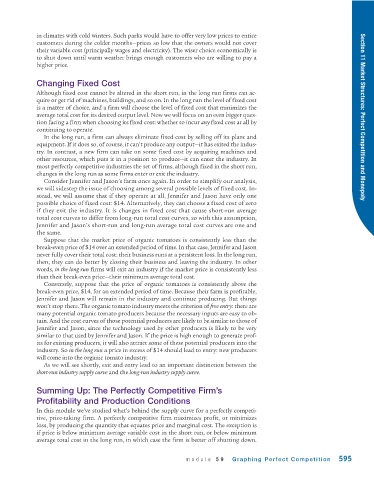Page 637 - Krugmans Economics for AP Text Book_Neat
P. 637
in climates with cold winters. Such parks would have to offer very low prices to entice
customers during the colder months—prices so low that the owners would not cover
their variable cost (principally wages and electricity). The wiser choice economically is
to shut down until warm weather brings enough customers who are willing to pay a
higher price.
Changing Fixed Cost
Although fixed cost cannot be altered in the short run, in the long run firms can ac-
quire or get rid of machines, buildings, and so on. In the long run the level of fixed cost
is a matter of choice, and a firm will choose the level of fixed cost that minimizes the
average total cost for its desired output level. Now we will focus on an even bigger ques- Section 11 Market Structures: Perfect Competition and Monopoly
tion facing a firm when choosing its fixed cost: whether to incur any fixed cost at all by
continuing to operate.
In the long run, a firm can always eliminate fixed cost by selling off its plant and
equipment. If it does so, of course, it can’t produce any output—it has exited the indus-
try. In contrast, a new firm can take on some fixed cost by acquiring machines and
other resources, which puts it in a position to produce—it can enter the industry. In
most perfectly competitive industries the set of firms, although fixed in the short run,
changes in the long run as some firms enter or exit the industry.
Consider Jennifer and Jason’s farm once again. In order to simplify our analysis,
we will sidestep the issue of choosing among several possible levels of fixed cost. In-
stead, we will assume that if they operate at all, Jennifer and Jason have only one
possible choice of fixed cost: $14. Alternatively, they can choose a fixed cost of zero
if they exit the industry. It is changes in fixed cost that cause short-run average
total cost curves to differ from long-run total cost curves, so with this assumption,
Jennifer and Jason’s short -run and long-run average total cost curves are one and
the same.
Suppose that the market price of organic tomatoes is consistently less than the
break-even price of $14 over an extended period of time. In that case, Jennifer and Jason
never fully cover their total cost: their business runs at a persistent loss. In the long run,
then, they can do better by closing their business and leaving the industry. In other
words, in the long run firms will exit an industry if the market price is consistently less
than their break-even price—their minimum average total cost.
Conversely, suppose that the price of organic tomatoes is consistently above the
break-even price, $14, for an extended period of time. Because their farm is profitable,
Jennifer and Jason will remain in the industry and continue producing. But things
won’t stop there. The organic tomato industry meets the criterion of free entry: there are
many potential organic tomato producers because the necessary inputs are easy to ob-
tain. And the cost curves of those potential producers are likely to be similar to those of
Jennifer and Jason, since the technology used by other producers is likely to be very
similar to that used by Jennifer and Jason. If the price is high enough to generate prof-
its for existing producers, it will also attract some of these potential producers into the
industry. So in the long run a price in excess of $14 should lead to entry: new producers
will come into the organic tomato industry.
As we will see shortly, exit and entry lead to an important distinction between the
short-run industry supply curve and the long-run industry supply curve.
Summing Up: The Perfectly Competitive Firm’s
Profitability and Production Conditions
In this module we’ve studied what’s behind the supply curve for a perfectly competi-
tive, price-taking firm. A perfectly competitive firm maximizes profit, or minimizes
loss, by producing the quantity that equates price and marginal cost. The exception is
if price is below minimum average variable cost in the short run, or below minimum
average total cost in the long run, in which case the firm is better off shutting down.
module 59 Graphing Perfect Competition 595

